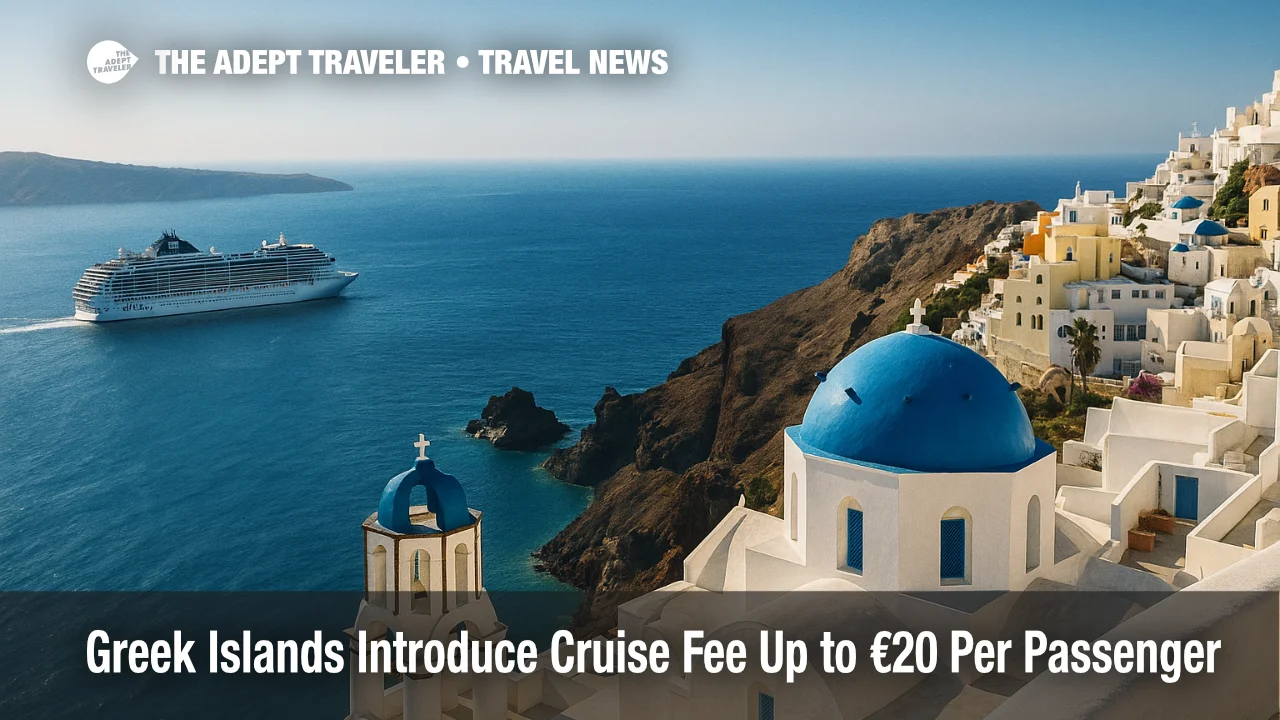Greek Islands Introduce Cruise Fee Up to €20 Per Passenger

Cruising the Aegean just got pricier. Beginning July 21 2025, Greece is collecting a new "sustainable tourism fee" from every cruise passenger who steps ashore on its islands. The levy ranges from €1 to €20, depending on season and port, and is highest at overtourism hotspots Mykonos and Santorini. Revenue will fund infrastructure upgrades and crowd-management projects, while cruise lines or their local agents must collect and remit the money each quarter. Travelers planning island-hopping itineraries should factor in the added cost-and potential enforcement delays-before booking.
Key Points
- Seasonal fee applies per passenger, per port.
- High-season rate: €20 (≈ $22 USD) at Mykonos and Santorini.
- Other islands charge €5 (≈ $6 USD) in summer.
- Why it matters: Overcrowded islands gain funds to improve ports and services.
- Cruise lines must pay quarterly via Greece's e-portal; non-payment triggers port bans.
Snapshot
Greece's cruise fee is officially branded the Sustainable Tourism Fee. It activates automatically whenever a passenger disembarks from a cruise ship at any Greek port. Three seasonal bands govern pricing. From June 1 through September 30, the peak rate is €20 at Mykonos and Santorini and €5 elsewhere. "Shoulder" months-October plus April 1 to May 31-drop the levy to €12 and €3, respectively. The winter low season, November 1 to March 31, sees fees fall to €4 at the two marquee islands and €1 for all other ports. Children and adults pay the same, and value-added tax does not apply. Cruise companies handle all filings through an online platform operated by the Ministry of Maritime Affairs and Insular Policy.
Background
Greece has wrestled with tourism pressures for years, especially on Mykonos and Santorini, where summer arrivals often overwhelm narrow roads, limited water supplies, and modest waste systems. In 2023 the Hellenic Parliament authorized targeted levies on accommodation and cruise traffic to redirect costs toward local infrastructure. A Joint Ministerial Decision published in the Government Gazette on June 30 2025 set the cruise fee schedule and enforcement rules. The measure aligns with broader European trends-Venice, Dubrovnik, and Amsterdam already impose visitor taxes-yet remains modest compared with older overnight levies. Industry body CLIA sought advance notice and reinvestment guarantees, eventually supporting the plan once proceeds were earmarked for port works.
Latest Developments
Greece's Coast Guard opened its dedicated e.hcg.gov.gr portal on July 1, giving agents three weeks to register vessels and test quarterly reporting. Cruise lines have since issued passenger advisories:
Seasonal Pricing Explained
High-season rates mirror peak congestion and coincide with the busiest cruise calendar. Shoulder-season discounts aim to spread demand into spring and autumn, supporting local businesses year-round without straining utilities. Winter's symbolic €1-€4 fee keeps the system active while recognizing minimal crowding.
Payment & Enforcement
Agents must log each disembarkation, listing ship IMO number, arrival time, and passenger count. Quarterly payments are due the last business day of April, July, October, and January. For 2025 only, summer disembarkations must be settled by October 31, with fourth-quarter fees due January 30 2026. Ports may deny berth assignments to vessels with outstanding balances, effectively grounding itineraries that skip compliance.
Overtourism Context
Mykonos welcomed 1.29 million cruise visitors aboard 768 ships last year-roughly 120 times its resident population on peak days. Santorini's caldera moorings faced similar strain, prompting daily caps and timed tender slots. Greek officials project the new fee could raise up to €50 million annually for pier extensions, shore-power installations, and waste-water plants, helping preserve the very scenery that draws travelers.
Analysis
For U.S. travelers, the additional cost is small-a family of four paying peak rates on both Mykonos and Santorini will see a €160 (≈ $179 USD) line item on the onboard bill. Yet the practical impacts run deeper. Cruise lines may adjust itineraries to avoid high-fee ports on budget sailings, shifting calls to nearby islands like Naxos or Syros. Luxury brands, by contrast, could lean into the policy, marketing smaller-group excursions and off-peak departures as sustainable upgrades. Advisors should brief clients on possible tender delays: port agents verifying fee compliance may hold clearance until databases update. Independent excursion operators are unaffected, but travelers should keep digital receipts handy in case of spot checks by port police. Overall, the levy signals Greece's intent to balance economic benefits with environmental stewardship-an approach likely to spread across Mediterranean destinations if successful.
Final Thoughts
The Greek cruise fee adds only a few euros to most vacations, yet it underscores a growing "pay-to-preserve" mindset worldwide. By budgeting for the charge, choosing shoulder-season sailings, and supporting local businesses ashore, travelers can help ensure the Aegean's famed whitewashed villages remain livable for residents and welcoming to future visitors-all while navigating the new Greek islands cruise fee.
